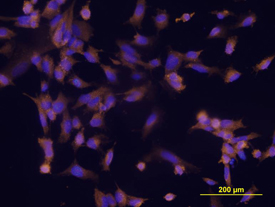Human ESAM Antibody Summary
Gln30-Ala247
Accession # Q96AP7
Applications
Please Note: Optimal dilutions should be determined by each laboratory for each application. General Protocols are available in the Technical Information section on our website.
Scientific Data
 View Larger
View Larger
Detection of ESAM in HUVEC Human Cells by Flow Cytometry. HUVEC human umbilical vein endothelial cells were stained with Mouse Anti-Human ESAM Monoclonal Antibody (Catalog # MAB4204, filled histogram) or isotype control antibody (Catalog # MAB0041, open histogram), followed by Phycoerythrin-conjugated Anti-Mouse IgG F(ab')2Secondary Antibody (Catalog # F0102B).
 View Larger
View Larger
ESAM in HUVEC Human Cells. ESAM was detected in immersion fixed HUVEC human umbilical vein endothelial cells using Mouse Anti-Human ESAM Monoclonal Antibody (Catalog # MAB4204) at 10 µg/mL for 3 hours at room temperature. Cells were stained using the NorthernLights™ 557-conju-gated Anti-Mouse IgG Secondary Antibody (yellow; Catalog # NL007) and counterstained with DAPI (blue). View our protocol for Fluorescent ICC Staining of Cells on Coverslips.
Reconstitution Calculator
Preparation and Storage
- 12 months from date of receipt, -20 to -70 °C as supplied.
- 1 month, 2 to 8 °C under sterile conditions after reconstitution.
- 6 months, -20 to -70 °C under sterile conditions after reconstitution.
Background: ESAM
Endothelial cell-selective adhesion molecule (ESAM) is a 55 kDa type I transmembrane glycoprotein that belongs to the JAM family of immunoglobulin superfamily molecules (1, 2). Human ESAM is synthesized as a 390 amino acid (aa) protein composed of a 29 aa signal peptide, a 216 aa extracellular region, a putative 26 aa transmembrane segment, and a 119 aa cytoplasmic domain. The extracellular region contains one V-type and one C2-type Ig domain and is involved in homophilic adhesion (1). In the cytoplasmic domain, there is a docking site for the multifunctional adaptor protein MAGI-1 (3). The extracellular region of human ESAM shows 90%, 74%, 69%, and 67% aa identity with monkey, canine, mouse, and rat extracellular ESAM, respectively. ESAM is expressed on endothelial cells, activated platelets, and megakaryocytes and can be found associated with cell-to-cell junctions. Whether ESAM is restricted to a particular junctional type is not clear (1, 2). ESAM deficient mice have no defect in vascularization but do have reduced angiogenic potential. This may be due to a decreased migratory response to FGF-2 (4).
- Hirata, K-I. et al. (2001) J. Biol. Chem. 276:16223.
- Nasdala, I. et al. (2002) J. Biol. Chem. 277:16294.
- Wegmann, F. et al. (2004) Exp. Cell Res. 300:121.
- Ishida, T. et. al. (2003) J. Biol. Chem. 278:34598.
Product Datasheets
FAQs
No product specific FAQs exist for this product, however you may
View all Antibody FAQsReviews for Human ESAM Antibody
There are currently no reviews for this product. Be the first to review Human ESAM Antibody and earn rewards!
Have you used Human ESAM Antibody?
Submit a review and receive an Amazon gift card.
$25/€18/£15/$25CAN/¥75 Yuan/¥1250 Yen for a review with an image
$10/€7/£6/$10 CAD/¥70 Yuan/¥1110 Yen for a review without an image

